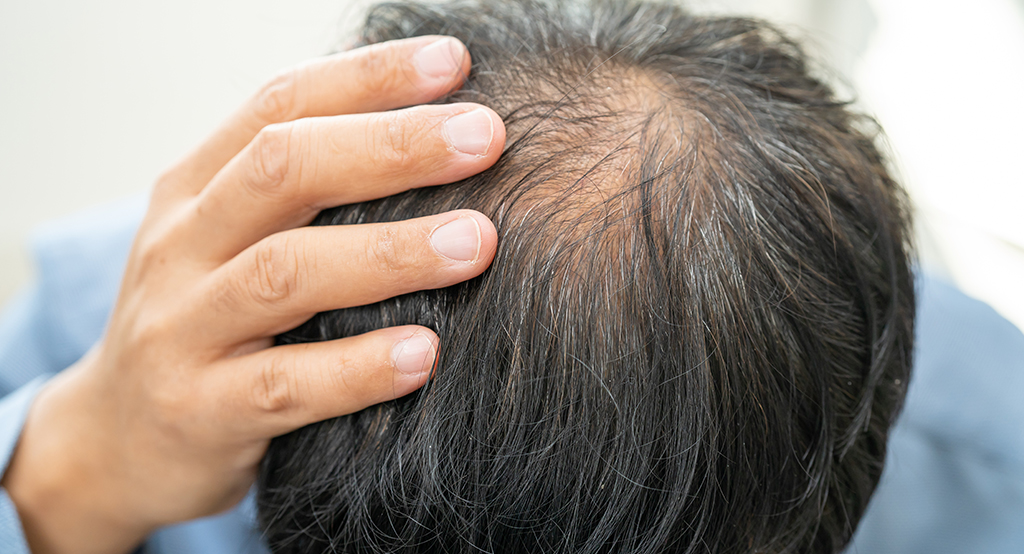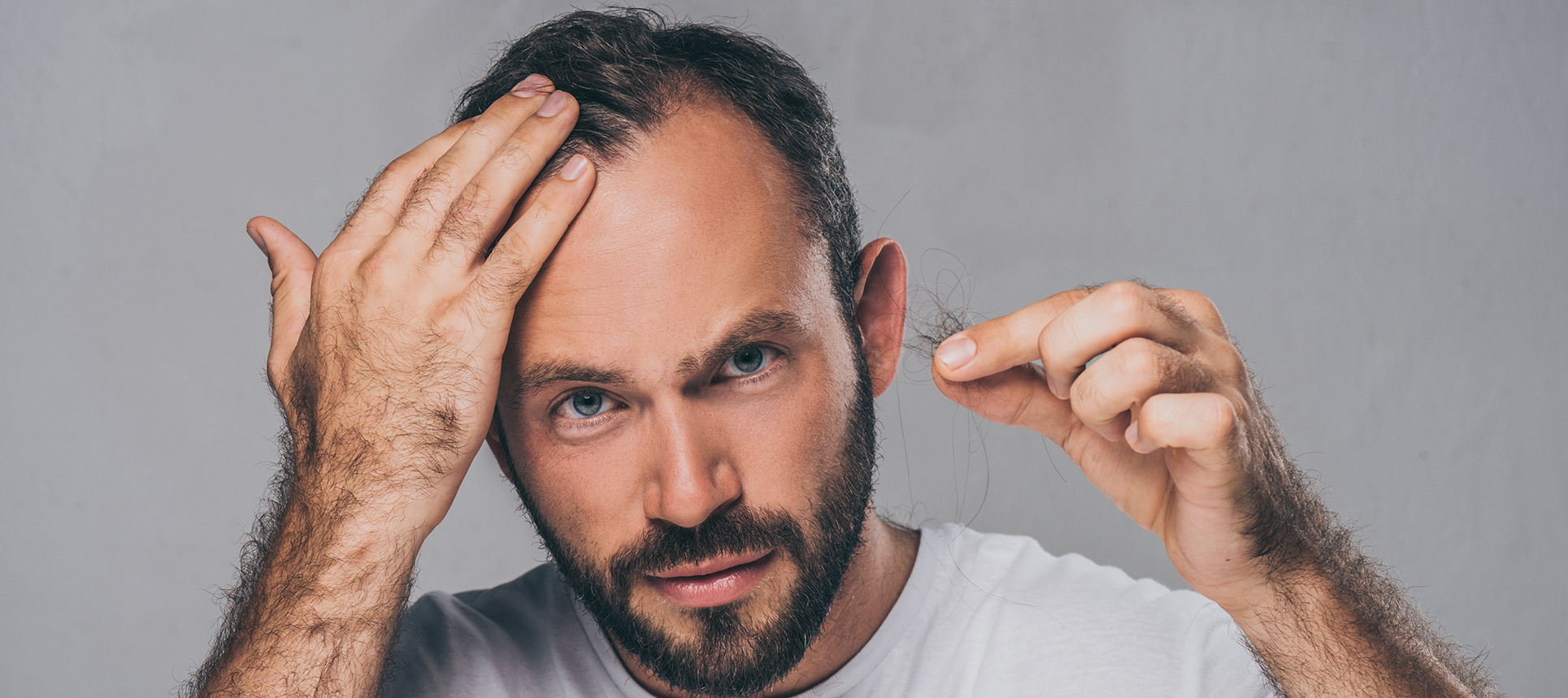Hair loss is a deeply personal and often distressing experience. Whether it’s a receding hairline, bald patches, or thinning across the scalp, the emotional toll can be significant. Many people find themselves checking the mirror daily, worrying about shedding, or avoiding certain hairstyles that might expose thinning areas. It can affect your confidence, your mood, and even your social interactions.
When the first signs appear, most of us look for answers quickly and that usually brings up the question: should I go to my GP and wait for an NHS referral, or should I see a private dermatologist?
It’s a question I hear often from patients and friends alike. And understandably so. The NHS and private practices both offer support for hair loss, but the path you take can make a huge difference in the speed, scope, and personalisation of your treatment.
While the NHS provides essential care and is free at the point of access, there are often long waiting times for dermatology referrals, and the range of treatments available may be limited depending on your location and the resources of your local NHS trust. Additionally, appointments may feel brief, with less opportunity to discuss lifestyle factors or the emotional impact of hair loss.
On the other hand, seeing a private dermatologist can offer faster access to consultations, often within days or weeks rather than months. Private clinics may have more time to take a detailed history, discuss the emotional and psychological effects of your hair loss, and carry out a thorough scalp examination. They may also have access to advanced diagnostic tools, such as trichoscopy (a type of scalp microscopy), blood tests tailored specifically to hair loss investigations, and even scalp biopsies if needed for complex cases.
Another key difference is in treatment options. While the NHS typically offers evidence-based treatments for medically significant hair loss conditions (such as alopecia areata or severe telogen effluvium), private dermatologists may offer a broader selection of treatments, including platelet-rich plasma (PRP) therapy, combination topical treatments, microneedling, and tailored supplement protocols, where appropriate. They can also provide personalised plans for conditions like male and female pattern hair loss, with closer monitoring and adjustment of treatments over time.
Of course, cost is a consideration, and private dermatology services require out-of-pocket payment or the use of private health insurance. However, many individuals find the investment worthwhile for the reassurance, clarity, and tailored treatment plans they receive.
In this article, I’ll walk you through the key differences between private and NHS dermatologists when it comes to treating hair loss. From consultation speed to diagnostic tools and advanced treatments, here’s what you need to know to make the best decision for your hair and your peace of mind.
The NHS Approach to Hair Loss

Let’s start with what you can expect from the NHS. If you’re experiencing hair loss, your first step will usually be to see your GP. They will take a history, examine your scalp, and may run some blood tests to rule out underlying health issues, such as thyroid problems or iron deficiency, which can sometimes contribute to hair loss.
If your GP believes a specialist opinion is needed, you’ll be referred to an NHS dermatologist. This might happen if your hair loss is sudden, severe, or causing visible patches, or if there’s a possibility of a scarring condition that needs urgent care.
Strengths of the NHS Approach:
- Free treatment: All NHS services are free at the point of use, which is a significant benefit.
- Standardised protocol: You’ll be treated based on evidence-backed guidelines.
- Focus on medical causes: The NHS takes a health-first approach and prioritises ruling out systemic issues.
Limitations:
- Waiting times: Getting an appointment with a dermatologist through the NHS can take weeks or even months.
- Limited treatment scope: NHS clinics often don’t offer cosmetic or advanced options like PRP or trichoscopy.
- Generic solutions: With limited time and resources, personalisation of treatment is often minimal.
In essence, the NHS route is solid if you suspect a medical condition behind your hair loss or need a diagnosis. It offers reassurance that serious causes will be checked, but it may not move as quickly or as comprehensively as you’d like if you are keen to start treatment or explore cosmetic options to support hair regrowth.
The Private Dermatology Difference
Now let’s explore how things work in the private sector. If you book a private consultation, you’ll often be seen within a week, sometimes even within a few days. Once you’re there, everything tends to move at a quicker pace consultation, diagnosis, and treatment planning can often happen in a single visit, allowing you to start your treatment journey sooner.
Key Benefits of Going Private:
- Shorter waiting times: You can often be seen in days, not weeks, which can be reassuring if you are anxious to find answers and begin treatment.
- More time with the specialist: Consultations are typically longer and more in-depth, allowing you to discuss your concerns fully and ask questions about your hair loss and treatment options.
- Access to advanced diagnostics: Tools like trichoscopy, scalp microscopy, and tailored blood tests help to get a clearer and more accurate picture of your hair and scalp condition, leading to more precise treatment plans.
- Tailored treatment plans: Prescriptions, topical treatments, and lifestyle recommendations are highly personalised, taking into account your specific type of hair loss, overall health, and preferences.
- Cosmetic treatments offered: Options like Platelet-Rich Plasma (PRP), mesotherapy, microneedling, and laser stimulation are available in private settings, giving you access to additional treatments that are not typically offered on the NHS.
In summary, if you are looking for a quicker diagnosis, more attention to detail, and access to a wider range of treatment options, going private is the faster and more flexible route. It allows you to take proactive steps towards managing your hair loss with a personalised plan that fits your needs and lifestyle.
Trichoscopy: The Diagnostic Edge

One of the biggest differences between NHS and private hair loss care is access to trichoscopy.
Trichoscopy is a non-invasive method that uses a dermatoscope to magnify the scalp and hair follicles, allowing dermatologists to examine your hair at high magnification. It helps detect patterns and subtle signs that are invisible to the naked eye such as miniaturisation of hair shafts, early thinning, or inflammation around hair follicles that could indicate an underlying condition.
Why it matters:
- Faster diagnosis: Trichoscopy provides immediate visual information, meaning there is often no need to wait for blood results or a biopsy unless it is necessary, speeding up the process of identifying the cause of hair loss.
- Accurate classification: It helps distinguish between conditions like androgenetic alopecia (pattern hair loss), telogen effluvium (shedding due to stress or illness), or alopecia areata (patchy hair loss), ensuring you receive the correct diagnosis.
- Tailored treatment: Knowing the exact type of hair loss allows for a far more targeted treatment approach, improving your chances of seeing results and reducing unnecessary treatments.
Trichoscopy isn’t typically offered in NHS clinics due to time constraints and resource limitations, as NHS dermatology often prioritises essential diagnostics and treatment. In private clinics, however, trichoscopy is a standard part of the initial assessment, providing valuable insights that can guide your treatment plan from the very first appointment.
Prescription-Only Topicals and Medications
Private dermatologists can also prescribe high-strength, customised topical treatments and advanced medications that go beyond what is typically available over the counter or through standard NHS prescriptions.
These prescription-only options may include:
- Minoxidil combinations: Enhanced versions of minoxidil that are combined with ingredients like retinoic acid or mild corticosteroids. These combinations can improve absorption into the scalp and reduce inflammation, making the treatment more effective in certain cases of hair loss.
- Topical finasteride: Applied directly to the scalp, topical finasteride helps to reduce levels of DHT (a hormone linked to hair thinning) locally while minimising systemic side effects that can occur with oral finasteride.
- Anti-androgens: For hormonal hair loss, particularly in women, private dermatologists may prescribe anti-androgens to address underlying hormonal imbalances contributing to hair thinning.
- Spironolactone or dutasteride: These medications can be used under close specialist supervision in more complex or resistant cases of hair loss, offering additional options for individuals who may not respond to first-line treatments.
Many of these prescription treatments aren’t available via NHS prescription due to budget restrictions, guidelines, or lack of licensing for certain uses in the UK. In private settings, however, dermatologists have the flexibility and discretion to use these treatments when they believe it is in the patient’s best interest, allowing for a more tailored and potentially more effective approach to hair loss management.
Platelet-Rich Plasma (PRP) Therapy
Platelet-Rich Plasma (PRP) therapy has become one of the most popular advanced treatments for hair loss and it’s almost exclusively available through private clinics.
How it works:
PRP involves taking a small sample of your blood and spinning it in a centrifuge to isolate the plasma rich in growth factors. This concentrated plasma is then carefully injected into areas of the scalp affected by thinning. The growth factors in PRP are believed to stimulate dormant hair follicles, encourage hair regrowth, and improve blood supply to the scalp, creating a healthier environment for hair growth.
Benefits of PRP:
- Natural and non-surgical: Since PRP uses your own blood, there are no added chemicals or medications involved, reducing the risk of adverse reactions.
- Clinically supported: Research has shown that PRP can improve hair density, increase hair thickness, and slow down the rate of shedding, making it a valuable option for many individuals experiencing hair loss.
- Customisable: PRP can be combined with treatments like microneedling or mesotherapy to enhance its effectiveness, allowing for a more comprehensive approach to hair restoration.
The NHS does not currently offer PRP as a treatment for hair loss, as it is considered a cosmetic procedure rather than a medical necessity. However, in private dermatology, PRP is becoming a go-to treatment option for individuals experiencing early-stage hair thinning or persistent hair loss who are looking for a natural, minimally invasive method to support hair regrowth and scalp health.
Speed of Diagnosis and Treatment
Timing is crucial when it comes to hair loss, as the longer you wait, the harder it can become to regain density especially in progressive conditions like androgenetic alopecia. One of the biggest differences between NHS and private dermatology is how quickly you can be seen and start treatment. On the NHS, the average wait time for an appointment is around 4 to 12 weeks, whereas in private dermatology, you can usually get an appointment within 3 to 7 days. The diagnostic process also differs; NHS services typically rely on a visual examination and basic blood tests, while private dermatologists often use advanced tools like trichoscopy and imaging alongside blood tests for a more detailed assessment. Treatment with the NHS generally starts only after completing the full referral process, which can take additional time, but in private clinics, treatment can often begin on the same day as your consultation. Additionally, the range of treatments available through the NHS is limited to what is included in their formulary, while private dermatology offers a full spectrum of options, including advanced and customised treatments. This faster, more flexible approach in private care can make a significant difference in stabilising your hair loss and preventing further progression.
A More Personalised Experience
Beyond the tools and treatments themselves, one of the most noticeable differences in private dermatology clinics is the level of personal attention you receive. Instead of the typical 10-minute GP visit, you will often have a dedicated consultation lasting 30 to 45 minutes, allowing the dermatologist to gain a thorough understanding of your situation.
During this time, your lifestyle, stress levels, nutrition, medical history, and hair care routine are all carefully explored, ensuring that nothing is overlooked. You’re not just seen as another case on a busy schedule you are treated as a whole person, with your individual concerns and goals taken seriously.
This often includes:
- A detailed lifestyle and medical history review
- Discussion of your current hair care routine and any recent changes
- Assessment of stress levels and mental well-being
- Nutritional review to check for deficiencies that may impact hair health
- Understanding your personal goals for hair regrowth and treatment expectations
This level of detail matters, especially since many types of hair loss can be triggered or worsened by factors like stress, illness, or dietary deficiencies. By looking deeper into your unique circumstances, private dermatologists can often create a more effective, targeted plan to address your hair loss and support your overall well-being.
When Should You See a Private Dermatologist?
Wondering if it’s time to consider private care for your hair loss? While the NHS provides a solid foundation for diagnosis and treatment, there are certain situations where seeking a private dermatologist can be the more practical, reassuring, and effective choice.
Here are a few situations where going private may be the better option:
- You’ve noticed sudden hair loss or bald patches and want a diagnosis fast. Sudden hair shedding or the appearance of bald spots can be alarming. A private dermatologist can assess your condition quickly, run any necessary tests, and begin treatment as soon as possible often within days rather than weeks or months.
- You’ve tried over-the-counter treatments like minoxidil with no success. If you have been using products such as minoxidil consistently without noticeable improvement, a private dermatologist can evaluate why the treatment may not be working and explore advanced prescription options or alternative therapies tailored to your hair and scalp.
- You want access to PRP or other cosmetic therapies. If you are interested in advanced treatments like Platelet-Rich Plasma (PRP), mesotherapy, or laser hair stimulation, private clinics are often the only way to access these options, as they are not offered through the NHS for hair loss.
- You need a second opinion after an NHS diagnosis. If you have received a diagnosis through the NHS but are unsure about the treatment plan or would like to explore additional options, a private consultation can provide a fresh perspective and potentially uncover treatment paths that align better with your needs and goals.
- You’re experiencing emotional distress from your hair loss and don’t want to wait months for help. Hair loss can significantly impact confidence and mental well-being. If the emotional burden is heavy, waiting for months on a referral list can feel overwhelming. Going private allows you to receive support, reassurance, and a plan of action much sooner, helping you regain a sense of control over your situation.
In essence, if your hair loss is causing you significant worry, if you value speed and personalisation, or if you are looking for advanced treatment options, seeing a private dermatologist can help you get answers and relief faster, supporting both your hair health and your peace of mind.
Final Thought: Your Next Step Towards Healthier Hair
Hair loss can feel overwhelming, especially when answers aren’t easy to find. While the NHS provides essential support for medical conditions, private dermatologists often offer faster access, more detailed diagnostics, and a broader toolkit of treatments. Whether you’re after cutting-edge therapies like PRP, tailored prescription solutions, or simply want to be seen quicker, the private route may give you the results you’re looking for with more control and peace of mind.
You can get in touch with us to book a consultation with one of our expert dermatologists in London and take the first step towards a personalised solution for your hair concerns.
References:
- Trueb, R.M., 2009. Oxidative stress in ageing of hair. International Journal of Trichology, 1(1), pp.6–14. https://www.ncbi.nlm.nih.gov/pmc/articles/PMC2840916/
- Ho, C.H., Sood, T., Zito, P.M., 2024. Alopecia. StatPearls Publishing. https://www.ncbi.nlm.nih.gov/books/NBK430924/
- Sinclair, R.D., 2015. Diffuse hair loss. International Journal of Dermatology, 54(4), pp.e392–e398. https://onlinelibrary.wiley.com/doi/10.1111/ijd.12712
- British Association of Dermatologists, 2022. Hair Loss. https://www.bad.org.uk/pils/hair-loss/
